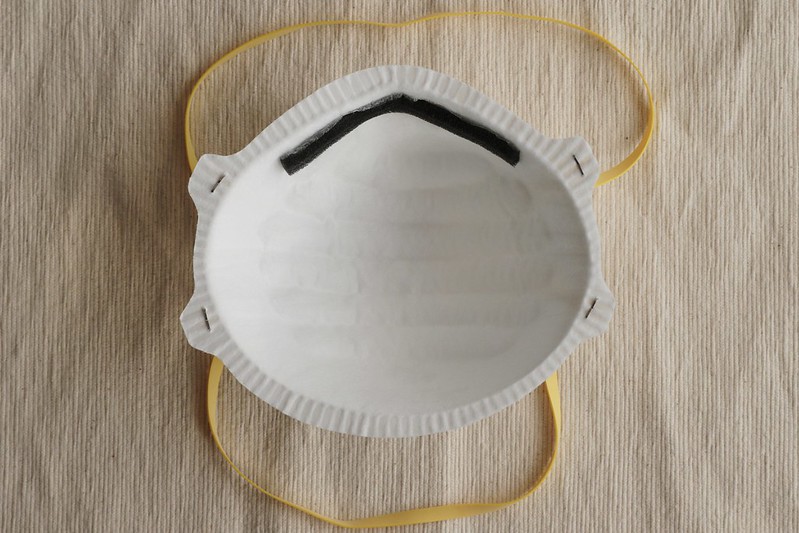On Masks and Breath
 Here in Seattle we are once again headed into a period of required mask wearing in public spaces. Many folks might be strongly advised to engage in double mask use in some contexts and depending on their mask selection (a thing I do myself, as my N95s have an exhalation valve). While masks don’t interfere with our oxygen levels, and mostly don’t make it any harder to breathe than wearing a scarf in the winter, they do change our experience of being out and about in the world, and even how we experience fundamental aspects of our own bodies.
Here in Seattle we are once again headed into a period of required mask wearing in public spaces. Many folks might be strongly advised to engage in double mask use in some contexts and depending on their mask selection (a thing I do myself, as my N95s have an exhalation valve). While masks don’t interfere with our oxygen levels, and mostly don’t make it any harder to breathe than wearing a scarf in the winter, they do change our experience of being out and about in the world, and even how we experience fundamental aspects of our own bodies.
There are many people around the country that have decided that mask wearing is an infringement on their rights, and some even have come the conclusion (or been ‘helped’ along to it) that it puts their health at risk. Why is this? What is it about the simple act of mask wearing that allowed it to be turned into a cultural flashpoint? What about wearing a mask is it that caused some people to say they can’t breathe with one on?
To answer this, we might first ask: What is the experience of wearing a mask like? The first thing most people will experience on putting on a good respirator or mask is that they are forced into a much more immediate relationship with their breath: how fast they are breathing, how hard, how deep. This is often not a particularly pleasant experience! While very often we’re directed to pay attention to our breath, to take a moment in inhale deeply, and “check in” with ourselves, doing that has a distinctly different flavor than the way wearing a mask tends to push your own breathing into the forefront of your experience.
The mask (properly worn and protecting others) forces one’s exhaled breath to stall inside the mask before it diffuses outwards. Similarly, an inhale does not feel as immediate, fresh, or powerful. While it’s not true that we’re inhaling stale air, it can sometimes feel that way. Our breathing is at some remove from the outside world, and this can produce a sense of discomfort.
Some of us have spent time in very cold environments, and worn various sorts of scarves or other warm coverings to keep out the cold in the winter. These too creates a remove from the world, traps moisture, and delays the immediacy of the act of breathing. The difference, of course, is that this feels better than breathing in the cold air directly! No frozen nostril hairs, no blast of bitterly cold, dry air hitting the back of the throat. Our scarves create a useful buffer between us and discomfort (and danger, if it’s cold enough).
For those of us who haven’t spent much time working with their breath, or who don’t have a lot of body awareness generally, the act of putting on a mask might be somewhat alarming. During the pandemic my cardiovascular fitness has definitely suffered, and walking briskly uphill can make me puff a bit. With a mask on, I am more acutely aware of the change in my breathing as I exert myself. If I did not pay much attention to how going up a flight of stairs might alter my breathing, I might find the much more noticeable increase in my rate of breathing to be concerning. And if I didn’t realize that what I was experiencing was normal (due to being a bit out of shape) and simply being brought to my attention by the mask on my face, I might blame the mask for causing me to be short of breath.
This experience might also hold true for people who are suffering from anxiety, or who are otherwise having an intense emotional experience (becoming angry, fearful, nervous, or otherwise keyed up). The changes in breathing that come along with heightened emotional states are often invisible, below the threshold of our attention. Put on a mask, and suddenly those changes can become much more noticeable, and might even amplify the emotion being felt.
It’s unfortunate that many of the people who might benefit from recontextualizing or understanding their mask wearing experience through this lens probably won’t be very receptive to talking about it, or to changing their views. The issue has gotten to be too charged with emotion and tied up in high-stakes cultural positions for much open discussion or personal exploration.
On the positive side of things, for those us who will be masking up to protect ourselves and others, doing so can present us with an opportunity to pay attention to our lived experience in a new way, through the masks that alters that experience. This is useful, but might not always be fun! I personally find that wearing a tightly-fitted N95 and a cloth mask over it squishes my nose sufficiently that breathing through my nose becomes pretty much impossible. I’m unfortunately prone to sinus problems and obstructions as it is, and even a bit of pressure on my nose can be enough to greatly reduce my ability to breathe through it.
This creates the chance for me to investigate my response to being forced to breathe through my mouth, along with the other things mentioned above. How do these things interplay with my mood? With the way the rest of my body feels? Is the act of walking the same? These are a few things to ponder while riding the bus or waiting in the checkout line.
